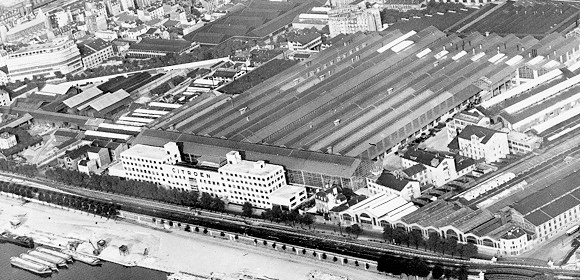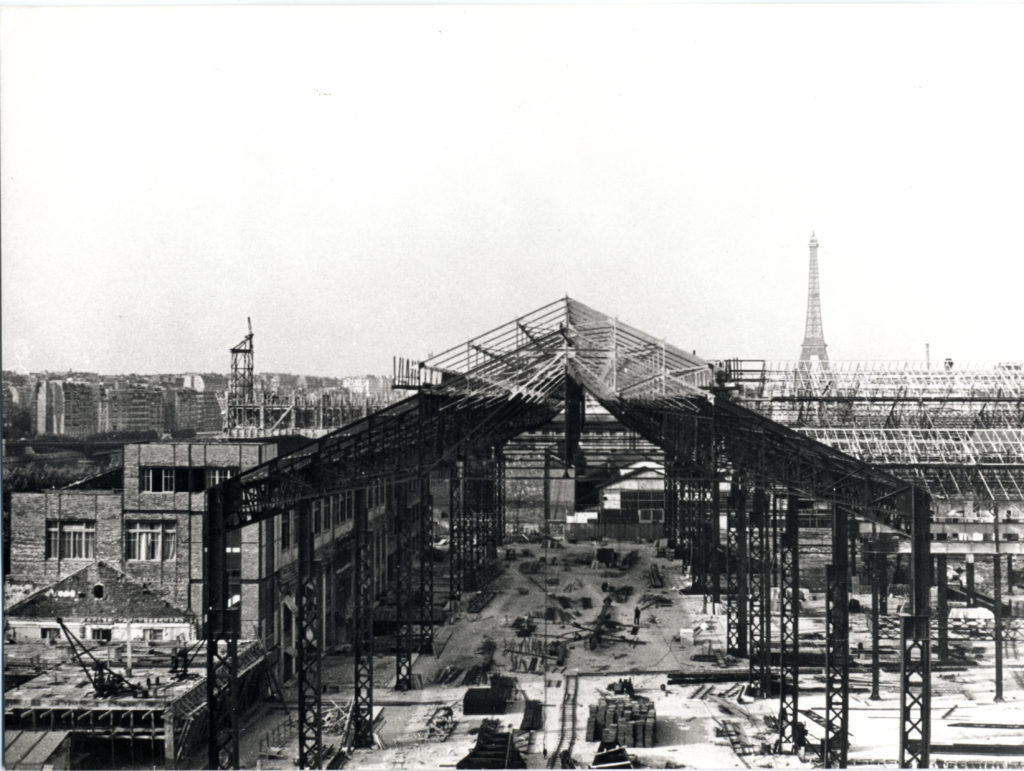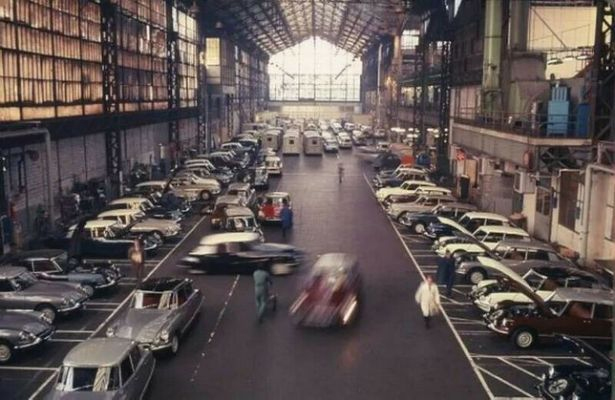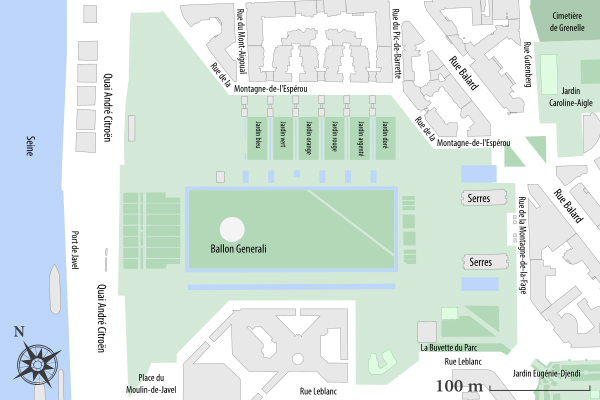History of the Quai de Javel Citroën Factory in Paris

The Citroën factory at Quai (Park) de Javel in Paris, was Citroën’s first and arguably most famous manufacturing plant. Located just 3 kilometers from the Eiffel Tower, in the 15th Arrondissement, it began producing Citroën cars in 1919, and turned out some of the company’s most iconic models up until 1975, when the last Citroën DS rolled off the assembly line and the factory was subsequently demolished to become Parc André-Citroën.

Here’s how the Quai de Javel Citroën factory came to be:
André Citroën was born in Paris on February 5th, 1878. His ancestors were fruit traders, an occupation from which they took the family name “Limoenman”, which his grandfather changed to the more exotic “Citroën,” the Dutch word for “Lemon.” His early aptitude in school gained him a spot at the prestigious Ecole Polytechnique (France’s state-supported institution of higher education and research) in 1898. But Citroën’s academic achievements appear to have stalled as he studied for a diploma in Engineering. He finished his education two years later, 159th out of 200 students in his class.

After graduation from the prestigious Ecole Polytechnique 1890, André Citroën joined the French army as an engineering officer. He ended up in Poland as a technically experienced engineer. There, he began to study double-helical (chevron cut) gears. For centuries, wooden double-helical gears were in use in Poland, powering water-driven machinery. They were beneficial not only because they ran quietly, but because they were able to transmit considerable loads without damage to the wood. Only one company in Russia was able to cut these gears successfully from steel, which would have tremendous application in the mechanized age. By 1904, Citroën filed a patent of his own and founded Engrenages Citroën, simultaneously developing the corporate logo featuring two double helical chevrons, which is still themed in the Citroën brand logo today.
By 1905, Citroën joined a new venture with André Boas and Jacques Hinstin. The new company was renamed Hinstin Freres Citroën & Cie, and made its mark selling its double helical gears to the automotive industry. Citroën brought in the latest machinery to produce his products, and firmly established his reputation as a visionary by embracing mass production as a way of keeping up with the tremendous demand. Within half a decade, Citroën’s gears were being used in most French cars, and were utilized in the steering system on the Titanic.

André Citroën’s brother was married to the daughter of the chairman of the board of Mors, a pioneering company in the early French automobile industry. By 1908, Mors was in dire straits. Mors’ early success in racing, in which it vanquished rival Panhard, had given way to terrible financial trouble during this period of depression in France. By this period, Mors was building only 10 of its large, expensive cars a month. Mors offered Citroën a temporary position to try and turn the company around. Citroën’s management style resurrected the brand to the point where the company was able to increase production tenfold (from 125 cars to 1,200 cars per year) by 1913.
When he finished his obligations at Mors, Citroën visited the Ford River Rouge plant in Detroit. He was impressed with the fact that Ford was building complete automobiles on a single floor assembly line, with abundant space and light, unlike Mors, which built cars in various departments on different floors.
In 1914, as an artillery officer in the French Army, Citroën saw that there was a great opportunity to mass-produce shells. Citroën presented a business plan to the Army’s Chief of Artillery, General Baquet. The French Ministry of Armaments provided Citroën with the funds to purchase thirty acres on the Quai de Javel in Paris to construct a massive factory complex, along with state-of-the-art machinery from North America in order to produce 20,000 shells per day. The Quai de Javel complex became a city in itself, containing not only production lines and shops, but medical and dental clinics. The plant employed more than 12,000 workers, who were mostly women. Citroën paid special attention to a support system for women covering pregnancy, birth and paid leave while nursing. By the height of the war, the Quay de Javel factory was turning out more than 35,000 shells every day.

As the war drew to a close and the requirement for munitions started to decline, Citroën began to look at other ways of utilizing a fully equipped precision manufacturing plant with enormous production capacity. Again, it was Ford’s automobile assembly line process that provided inspiration.
The decision to switch to automobile manufacturing was taken as early as 1916, which is the year when Citroën asked the engineer Louis Dufresne, previously with Panhard, to design a technically-sophisticated 18HP automobile for which he could use his factory once peace returned. Long before that happened, however, he had modified his vision and decided, like Henry Ford, that the best post-war opportunities in auto-making would involve a lighter car of good quality, but made in sufficient quantities to be priced enticingly. In February 1917, Citroën contacted another engineer, Jules Salomon, who already had a considerable reputation within the French automotive sector as the creator, in 1909, of a little car called Le Zèbre.
Within four months following the end of the war, the Quay de Javel factory had been converted to automobile manufacture, and a new name came into existence, ‘S.A. André Citroën’. The Type A was launched in April and was put into production on the 28th of May, 1919.
The Quai de Javel Citroën factory was the most modern of its day in Europe (100 vehicles/day in 1919 and 200 vehicles/day by1924).
In 1933, despite a particularly difficult financial situation, Citroën decided to completely rebuild the factory for production of the Traction Avant in just five months, without stopping production.

That decision resulted in Michelin taking over the Citroën company in receivership in 1934, and although André Citroën died on July, 3 1935, (the official cause stated was stomach cancer, but many have attributed it to a broken heart), the company was again turning a profit by 1936 and innovation continued as did production at Quai de Javel.

On 9 October 1958, while the Paris Motor show was running, the city fathers renamed the Quai de Javel as the “Quai André-Citroën,” in recognition of André Citroën its location for Europe’s first mass production car plant.


The Quai de Javel, renamed Quai André Citroën in 1958, produced its last DS in April 1975 and was then demolished during an eight year period, between 1976 and 1984.
In 1992, a public garden in Paris was built on the site and named in honour of André Citroën; now called Parc André Citroën.



Did they have a facility in North Africa? I have a picture from winter of 1943 with a military parade (Free French, British & US) outside a large building with Citroen. It is next to another large building with a sign that says CASINO.
Any idea of where that plant was located?
Thanks for any help – direction